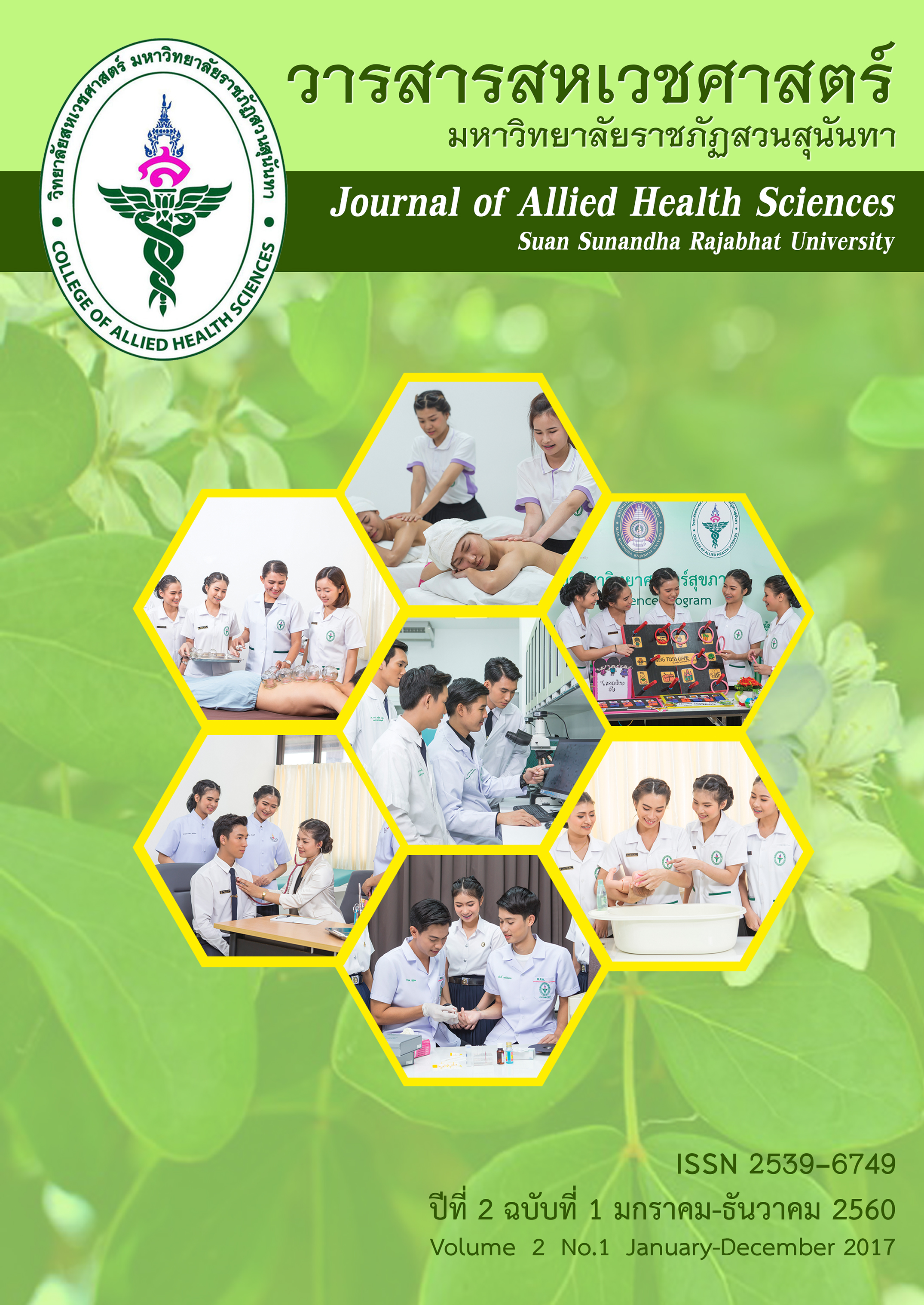ผลของการนวดกดจุดสะท้อนฝ่าเท้าร่วมกับการใช้ยาต่อระดับน้ำตาลในเลือด และการสูญเสียการรับความรู้สึกที่เท้าในผู้สูงอายุเป็นเบาหวานชนิดที่ 2 Effects of Foot Reflexology Combined with Medication on Blood Sugar and Sensory Loss on the Foot in Older Adults with Type 2 Diabetes
Main Article Content
บทคัดย่อ
ผู้สูงอายุที่ป่วยเป็นเบาหวานชนิดที่ 2 มีความเสี่ยงต่อการเกิดภาวะแทรกซ้อนที่เท้า และนำไปสู่การถูกตัดนิ้วเท้าหรือขามากกว่าผู้เป็นเบาหวานวัยผู้ใหญ่ทั่วไป การศึกษาครั้งนี้เป็นการวิจัยแบบทดลอง มีวัตถุประสงค์เพื่อศึกษาผลของการนวดกดจุดสะท้อนฝ่าเท้าต่อระดับน้ำตาลในเลือด และการสูญเสียการรับความรู้สึกที่เท้า ในผู้สูงอายุเป็นเบาหวานชนิดที่ 2 โดยวิธีสุ่มเปรียบเทียบ กลุ่มตัวอย่างคือผู้สูงอายุเป็นเบาหวานชนิดที่ 2 ที่มาใช้บริการแผนกผู้ป่วยนอก โรงพยาบาลมโนรมย์ อำเภอมโนรมย์ จังหวัดชัยนาท จำนวน 40 ราย ในระหว่างวันที่ 5 มกราคม พ.ศ. 2558 ถึง วันที่ 30 มิถุนายน พ.ศ. 2558 โดยการสุ่มแบบง่ายด้วยการจับฉลากแบบใส่คืน แบ่งเป็นกลุ่มทดลองจำนวน 20 ราย ได้รับการนวดกดจุดสะท้อนฝ่าเท้า นวดทุกวันเป็นเวลา 2 เดือน และกลุ่มควบคุมจำนวน 20 รายไม่ได้รับการนวด ตัวอย่างทุกรายได้รับการรักษาด้วยยาชนิดรับประทานหรือใช้ยาอินซูลินชนิดฉีดตามแผนการรักษา ตรวจวัดระดับน้ำตาลในเลือดและตรวจการสูญเสียการรับความรู้สึกที่เท้าด้วย Semmes-Weinstein Monofilament 10 g. (SWM) วิเคราะห์ข้อมูลด้วยสถิติการแจกแจงความถี่, ร้อยละ, Independent t-test และ Paired t-test.
ผลการวิจัยพบว่า ภายหลังได้รับการนวดกดจุดสะท้อนฝ่าเท้า 2 เดือน กลุ่มทดลองมีระดับน้ำตาลในเลือดน้อยกว่ากลุ่มควบคุม (t = 2.76, p = 0.003) มีการสูญเสียการรับความรู้สึกที่เท้าลดลง ทั้งเท้าขวาและเท้าซ้าย (ร้อยละ 42.84 และ 50.00 ตามลำดับ) และพบว่าภายหลังกลุ่มทดลองได้รับการนวดกดจุดสะท้อนฝ่าเท้ามีระดับน้ำตาลในเลือดน้อยกว่าก่อนนวด (t = 31.642, p < 0.001) และมีการสูญเสียการรับความรู้สึกที่เท้าทั้ง 2 ข้างลดลงกว่าก่อนนวด (t = 5.912, p < 0.001) นอกจากนี้ยังพบว่าไม่มีการสูญเสียการรับความรู้สึกที่เท้าเพิ่มขึ้น (t = -2.052, p < 0.05)
ผลการศึกษานี้แสดงให้เห็นว่าโปรแกรมการนวดกดจุดสะท้อนฝ่าเท้าสามารถนำไปใช้ในการปฏิบัติทางการพยาบาล เพื่อลดความรุนแรงของภาวะแทรกซ้อนที่เท้าและเพิ่มคุณภาพชีวิตให้กับผู้สูงอายุเป็นเบาหวานชนิด ที่ 2 ได้
Foot ulcers are considered the most important diabetic complications that result in leg and foot amputation in older adults with type 2 diabetes. This present study was experimental design with randomized controlled trial objectives at the effects of foot reflexology combined with the medication on blood sugar and sensory loss on the foot in older adults with type 2 diabetes. The study sample consisted of 40 older adults with type 2 diabetes mellitus who sought treatment at the diabetes clinic at Manorom Hospital in Chai Nat Province who met the inclusion criteria. The subjects were recruited through random sampling, with 20 assigned into the experimental group and the other 20 into the control group. The subjects in the experimental group received foot reflexology every day for a period of two months, while those in the control group did not receive such treatment. All of the subjects in both groups received pharmacological treatment of diabetes with either oral medication or insulin injection as prescribed in the treatment plan based on their fasting plasma glucose levels and perception sensory loss with Semmes-Weinstein Monofilament 10 g. Data were analysed using descriptive statistics, and inferential statistics independent t-test and paired t-test.
The results revealed that after receiving foot reflexology, the FPG of the experimental subjects was lower than that of the control subjects (t = 2.76, p = 0.003). In addition, their sensory loss in the right foot and left foot were reduce than those of the control subjects the loss sensation point in the right foot were reduce 42.85 % in the left foot were reduce 50.0 %. Also, after receiving foot reflexology, the subjects in the experimental group had lower FPG (t = 31.642, p < 0.001) and a loss of sensation in the foot decrease than before treatment (t = 5.912, p < 0.001) was also found that there was not sensation of loss in the foot increase than before foot reflexology (t = -2.052, p < 0.05).
Results revealed that foot reflexology should be implemented as a complementary therapy to control diabetes and reduce severity of complication on diabetic foot in older adults with type 2 diabetes mellitus.

